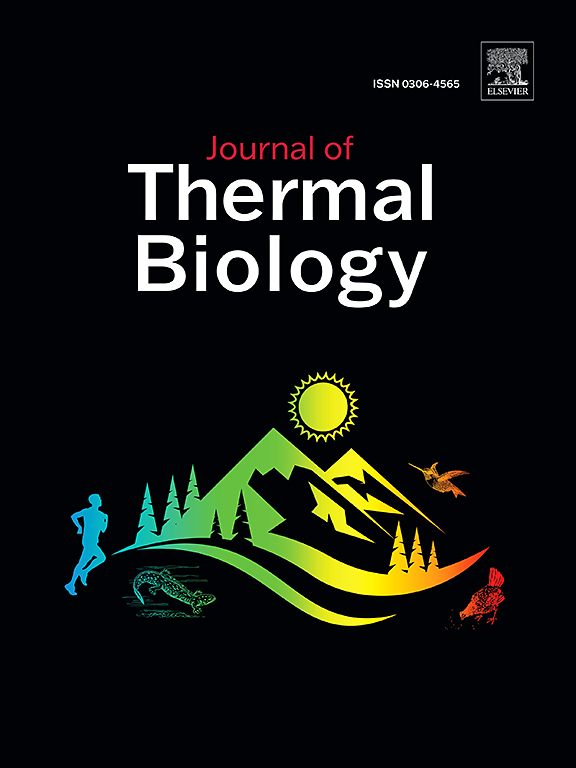利用红外热成像技术分析应激条件下饲养的山羊体温和阴囊表面温度的动态变化:分析视角
IF 2.9
2区 生物学
Q2 BIOLOGY
引用次数: 0
摘要
红外热成像(IRT)是一种分析动物体表温度变化的重要非侵入性方法,可为了解家畜的应激反应提供宝贵的信息。尽管山羊具有顽强的生命力,但在热应激和缺水等极端条件下仍会面临巨大挑战。本实验旨在利用 IRT 分析山羊在这两种情况下全身和阴囊表面温度的动态变化。八只健康的阿尔迪公羊接受了三种 72 小时的处理:缺水、脱水和补水。连续气象监测提供了环境温度、相对湿度和温湿度指数(THI)值。每天 8:00 和 15:00 测量两次体表温度,并计算环境温度与体表或阴囊表面温度之间的热梯度。根据获得的平均 THI 值,雄鹿在整个实验期间都经历了热应激。此外,结果表明,不同处理和不同时间点的体表温度存在明显差异,这体现在温度的中心倾向、变异性、形状描述符和频率分布上。上午的测量结果表明,缺水时的温度和温度梯度较低,而缺水时的温度较高,热调节功能受到影响。相反,下午的数据显示温度反应的变异性更大,突出了昼夜热应激和缺水的复合效应。虽然补水减轻了缺水的一些影响,但并不能完全将热平衡恢复到缺水水平。热梯度进一步强调了山羊的动态体温调节机制,这种机制在缺水情况下受到损害,尤其是在阴囊区域,但在恢复后又得到了部分恢复。这些研究结果证明了 IRT 在评估山羊热反应方面的有效性,并强调了充足的水合对在热应激下保持热平衡的重要性。本文所做的分析提供了宝贵的见解,对热应激和缺水山羊的整体健康、繁殖效率、生产率和福利都有影响,可为今后研究牲畜对此类挑战性环境条件的适应性提供一个框架。本文章由计算机程序翻译,如有差异,请以英文原文为准。
Profiling the dynamic variations in body and scrotal surface temperatures of goats reared under stressful conditions using infrared thermography: Analytical perspectives
Infrared thermography (IRT) is an essential non-invasive method for analyzing surface temperature variations in animals, offering valuable insights into livestock stress responses. Despite their resilience, goats can face significant challenges under extreme conditions like heat-stress and water deprivation. This experiment aimed to delineate the dynamic variations in whole-body and scrotal surface temperatures in goats subjected to the combined impact of both conditions using IRT. Eight healthy Aardi bucks were exposed to three 72-h treatments: euhydration, dehydration, and rehydration. Continuous meteorological monitoring provided ambient-temperature, relative-humidity, and temperature-humidity index (THI) values. Surface temperatures were measured twice daily at 08:00 and 15:00, and thermal gradients between ambient and body or scrotal surface temperatures were computed. Based on the obtained mean THI values, the bucks experienced heat-stress throughout the experiment. Additionally, results revealed noticeable variations in both surface temperatures across treatments and time points, indicated by measures of central tendency, variability, shape descriptors, and frequency distribution of temperature. Morning measurements indicated lower temperatures and gradients under euhydration, while water deprivation led to higher temperatures and compromised thermal regulation. Conversely, afternoon data showed higher variability in temperature responses, highlighting the compounded effect of diurnal heat-stress and water deprivation. Although water-restoration mitigated some effects of deprivation, it did not fully restore thermal homeostasis to euhydrated levels. Thermal gradients further emphasized the goats' dynamic thermoregulatory mechanisms, which were compromised under water deprivation, particularly in the scrotal region, but were partially restored upon restoration. These findings demonstrate the effectiveness of IRT in assessing thermal responses in goats and underscore the importance of adequate hydration for maintaining thermal balance under heat-stress. The herein performed profiling provides valuable insights with implications for overall health, reproductive efficiency, productivity, and welfare in heat-stressed and water-deprived goats, which might offer a framework for future research on livestock adaptation to such challenging environmental conditions.
求助全文
通过发布文献求助,成功后即可免费获取论文全文。
去求助
来源期刊

Journal of thermal biology
生物-动物学
CiteScore
5.30
自引率
7.40%
发文量
196
审稿时长
14.5 weeks
期刊介绍:
The Journal of Thermal Biology publishes articles that advance our knowledge on the ways and mechanisms through which temperature affects man and animals. This includes studies of their responses to these effects and on the ecological consequences. Directly relevant to this theme are:
• The mechanisms of thermal limitation, heat and cold injury, and the resistance of organisms to extremes of temperature
• The mechanisms involved in acclimation, acclimatization and evolutionary adaptation to temperature
• Mechanisms underlying the patterns of hibernation, torpor, dormancy, aestivation and diapause
• Effects of temperature on reproduction and development, growth, ageing and life-span
• Studies on modelling heat transfer between organisms and their environment
• The contributions of temperature to effects of climate change on animal species and man
• Studies of conservation biology and physiology related to temperature
• Behavioural and physiological regulation of body temperature including its pathophysiology and fever
• Medical applications of hypo- and hyperthermia
Article types:
• Original articles
• Review articles
 求助内容:
求助内容: 应助结果提醒方式:
应助结果提醒方式:


